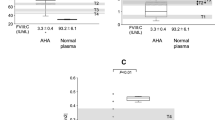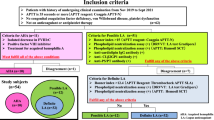Abstract
Acquired coagulation factor inhibitors are rare. Among them, coagulation factor V (FV) inhibitor is particularly uncommon and presents with variable clinical manifestations. Certain acquired FV inhibitor patients have only mild bleeding or, in select cases, no symptoms at all, leading to spontaneous recovery. Others have life-threatening bleeding that requires medical attention. Thus, a prompt decision regarding diagnosis and clinical intervention is crucial for such patients. In five acquired FV inhibitor cases treated in our facility, each patient had a malignancy as an underlying disease and all unexpectedly showed prolongation of both prothrombin time (PT) and activated partial thromboplastin time (APTT). They all also displayed a discrepancy between PT and Normotest (Hepaplastintest, HPT) results. All but one patient experienced no bleeding at the time of diagnosis and achieved spontaneous recovery in 1–3 weeks. The patient with bleeding symptoms received plasma exchanges and a platelet transfusion. Useful markers in diagnosing the presence of an acquired FV inhibitor were a sudden prolongation of PT and APTT, and a discrepancy between the PT/APTT and HPT assays. Spontaneous recovery can be expected for patients with only minor bleeding.


Similar content being viewed by others
References
Franchini M, Lippi G. Acquired factor V inhibitors: a systematic review. J Thromb Thrombolysis. 2011;314:449–57.
Wang X, Qin X, Yu Y, Wang R, Liu X, Ji M, et al. Acquired factor V deficiency in a patient with a urinary tract infection presenting with haematuria followed by multiple haemorrhages with an extremely low level of factor V inhibitor: a case report and review of the literature. Blood Coagul Fibrinolysis. 2017;28:334–41.
Tanaka I, Amano K, Taki M, Oka T, Sakai M, Shirahata A, et al. A 3-year consecutive survey on current status of acquired inhibitors against coagulation factors in Japan—analysis of prognostic factors. Jpn J Thromb Hemost. 2008;19:140–53.
Ogawa Y, Yanagisawa K, Uchiumi H, Ishizaki T, Mitsui T, Gouda F, et al. Clinical characteristics and outcomes of acquired hemophilia A: experience at a single center in Japan. Int J Hematol. 2017;106:82–9.
Streiff MB, Ness PM. Acquired FV inhibitors: a needless iatrogenic complication of bovine thrombin exposure. Transfusion. 2002;42:18–26.
Ang AL, Kuperan P, Ng CH, Ng HJ. Acquired factor V inhibitor. A problem-based systematic review. Thromb Haemost. 2009;101:852–9.
Owren PA, Standi OK. Normotest. Farmakotherapi. 1969;25:14.
Tsukada H, Shimoda T, Matsuo N, Hiraishi A, Shimoyama C, Arai H, et al. Study on Normotest (Hepaplastin test). Blood Vessel. 1976;7:111–8.
Takeuchi T, Ueno T, Arai H, Maekawa T, Tsukada H. Studies of Normotest (Hepaplastin test) on control of anticoagulant therapy. Blood Vessel. 1977;8:320–5.
Ashizawa M, Kimura S, Wada H, Sakamoto K, Sato M, Terasako K, et al. Acquired factor V inhibitor associated with life-threatening bleeding and a mixing test result that indicated coagulation factor deficiency. Hematology. 2013;18:300–4.
Nesheim ME, Nichols WL, Cole TL, Houston JG, Schenk RB, Mann KG, et al. Isolation and study of an acquired inhibitor of human coagulation factor V. J Clin Investig. 1986;77:405–15.
Chediak J, Ashenhurst JB, Garlick I, Desser RK. Successful management of bleeding in a patient with factor V inhibitor by platelet transfusions. Blood. 1980;56:835–41.
Lebrun A, Leroy-Matheron C, Arlet JB, Bartolucci P, Michel M. Successful treatment with rituximab in a patient with an acquired factor V inhibitor. Am J Hematol. 2008;83:163–4.
Ma ES, Liang RH, Chu KM, Lau GK. Complete response of acquired FV inhibitor to rituximab. Int J Hematol. 2015;101:421–2.
Acknowledgements
This study was supported in part by research aids from the Japanese Ministry of Health, Labor, and Welfare (to A.I.). We would like to thank all members of the “Japanese Collaborative Research Group (JCRG) on Autoimmune Haemorrhaphilia”.
Author information
Authors and Affiliations
Corresponding author
Ethics declarations
Conflict of interest
The authors declare no conflicts of interest in association with the present study.
About this article
Cite this article
Kadohira, Y., Yamada, S., Hayashi, T. et al. A discrepancy between prothrombin time and Normotest (Hepaplastintest) results is useful for diagnosis of acquired factor V inhibitors. Int J Hematol 108, 145–150 (2018). https://doi.org/10.1007/s12185-018-2453-z
Received:
Revised:
Accepted:
Published:
Issue Date:
DOI: https://doi.org/10.1007/s12185-018-2453-z




